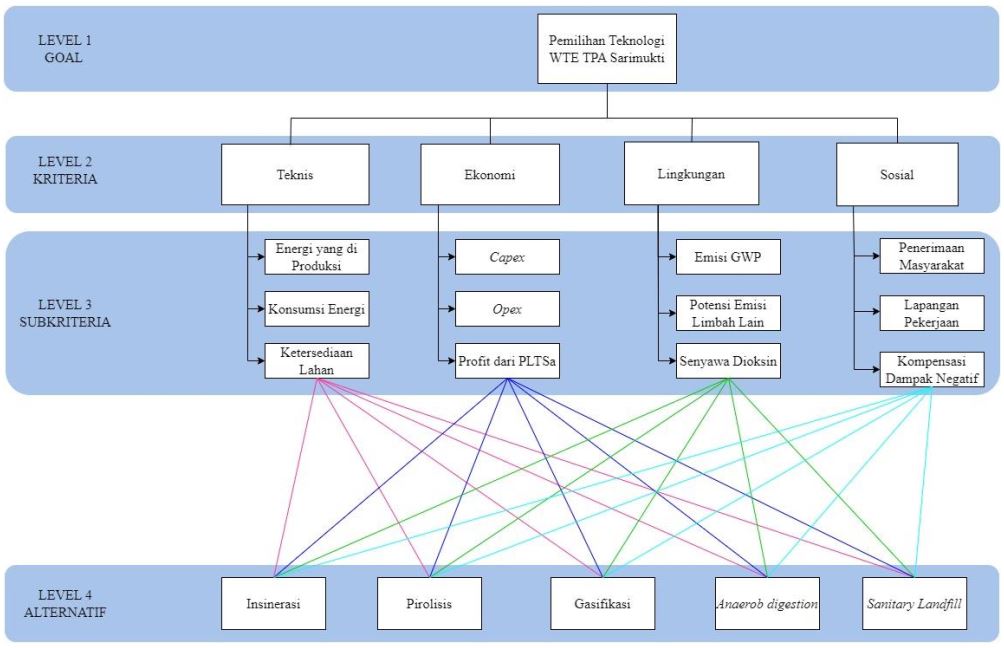WASTE TO ENERGY TECHNOLOGY SELECTION USING THE ANALYTICAL HIERARCHY PROCESS METHOD IN THE SARIMUKTI FINAL DISPOSAL BANDUNG, WEST JAWA
DOI:
https://doi.org/10.51401/altron.v2i02.2836Keywords:
Waste, energy, technology, criteria, alternatives, gasificationAbstract
Waste as a residue from human activities can become a problem when it is not managed properly. The volume of waste that continues to increase and the limited land for waste management are factors in the waste problems that arise in several cities in Indonesia, one of which is Bandung Raya. One solution that can be used to manage municipal waste is to use waste-to-energy technology. Several alternative technologies that can be applied to manage waste into energy are incineration, gasification, pyrolysis, anaerobic digestion, and sanitary landfills. There are several multi-criteria considerations for choosing the right technology for decision-makers in waste management. One method that can be used to select a multi-criteria waste management technology is the Analytical Hierarchy Process (AHP) method. The results of the study show that the quantity and quality of Bandung waste have an energy potential of up to 292.08 MW. Based on the results of the interviews, the criteria for selecting Bandung waste consider technical aspects, environmental aspects, economic aspects, and social aspects. The technical aspect is the biggest consideration compared to other aspects because it has the highest weight. Gasification technology is the chosen alternative technology for waste management in Bandung because it has the highest weight rating compared to other alternatives.
Keywords: Waste, energy, technology, criteria, alternatives, gasification.
References
B. Anggoro, A. Aprilian, and B. Halimi, “Potency of waste to energy - Bandung City case study,” in International Conference on High Voltage Engineering and Power Systems, ICHVEPS 2017 - Proceeding, 2017. doi: 10.1109/ICHVEPS.2017.8225929.
S. N. Qodriyatun, “Pembangkit Listrik Tenaga Sampah: Antara Permasalahan Lingkungan dan Percepatan Pembangunan Energi Terbarukan,” Aspirasi: Jurnal Masalah-masalah Sosial, vol. 12, no. 1, pp. 63–84, Jun. 2021, doi: 10.46807/aspirasi.v12i1.2093.
M. Chaerul, “Composting Technology Selection: AHP Approach. (in Indonesian),” 2011, [Online]. Available: https://www.researchgate.net/publication/320611676
F. D. Qonitan, I. Wayan Koko Suryawan, and A. Rahman, “Overview of Municipal Solid Waste Generation and Energy Utilization Potential in Major Cities of Indonesia,” in Journal of Physics: Conference Series, 2021. doi 10.1088/1742-6596/1858/1/012064.
M. I. Yuniar, D. Notosudjono, and E. Wismiana, “Studi Potensi Pemanfaatan Sampah Melalui Perencanaan Biodigester Untuk Pembangkit Tenaga Listrik Di Kota Bandung,” Jurnal Online Mahasiswa (Jom) Bidang Teknik Elektro, vol. 1, no. 1, 2017.
A. D. Pasek, K. W. Gultom, and A. Suwono, “Feasibility of recovering energy from municipal solid waste to generate electricity,” Journal of Engineering and Technological Sciences, vol. 45, no. 3, 2013, doi: 10.5614/j.eng.technol.sci.2013.45.3.3.
B. Prabowo, F. S. H. Simanjuntak, Z. S. Saldi, Y. Samyudia, and I. J. Widjojo, “Assessment of waste to energy technology in Indonesia: A techno-economical perspective on a 1000 ton/day scenario,” International Journal of Technology, vol. 10, no. 6, 2019, doi: 10.14716/tech.v10i6.3607.
M. M. Azis, J. Kristanto, and C. W. Purnomo, “A techno?economic evaluation of municipal solid waste (Msw) conversion to energy in Indonesia,” Sustainability (Switzerland), vol. 13, no. 13, 2021, doi: 10.3390/su13137232.
H. Sudibyo, A. I. Majid, Y. S. Pradana, W. Budhijanto, Deendarlianto, and A. Budiman, “Technological Evaluation of Municipal Solid Waste Management System in Indonesia,” in Energy Procedia, Elsevier Ltd, 2017, pp. 263–269. doi 10.1016/j.egypro.2017.03.312.
A. Feisal and A. Surjosatyo, “Techno-Economic Analysis of Municipal Solid Waste Gasification System for Electric Generation, Case Study: City at Central Java,” in IOP Conference Series: Earth and Environmental Science, IOP Publishing Ltd, Dec. 2021. doi 10.1088/1755-1315/926/1/012110.
D. Octavianthy and W. W. Purwanto, “Municipal solid waste to electricity using anaerobic digestion and incineration conversion technologies: A comparative study,” in 2nd IEEE International Conference on Innovative Research and Development, ICIRD 2019, 2019. doi: 10.1109/ICIRD47319.2019.9074751.
W. Elsha, “Studi Komparasi Teknologi Waste to Energy (WtE) pada Municipal Solid Waste Management (MSWM) di Provinsi Daerah Istimewa Yogyakarta,” Universitas Gadjah Mada, Yogyakarta, 2022.
Di. R. T. Rivera, T. A. Arce, F. R. Abistano, C. J. Bathan, and A. A. Palo, “Waste to Energy Technologies using Multi-Criteria Decision Analysis for Municipal Solid Waste Management in Manila City, Philippines,” in 2021 IEEE 13th International Conference on Humanoid, Nanotechnology, Information Technology, Communication and Control, Environment, and Management, HNICEM 2021, Institute of Electrical and Electronics Engineers Inc., 2021. doi: 10.1109/HNICEM54116.2021.9731978.
W. A. Qazi, M. F. M. Abushammala, and M. H. Azam, “Multi-criteria decision analysis of waste-to-energy technologies for municipal solid waste management in Sultanate of Oman,” Waste Management and Research, vol. 36, no. 7, 2018, doi: 10.1177/0734242X18777800.
L. Parinduri, T. Parinduri, K. Kunci, E. Fosil, E. Biomassa, and K. Energi, “Konversi Biomassa Sebagai Sumber Energi Terbarukan,” 2020. [Online]. Available: https://www.dosenpendidikan.

Published
How to Cite
Issue
Section
Copyright (c) 2023 Putri Vicky Hapsari, Rochim Bakti Cahyono , Nur Aini Masruroh

This work is licensed under a Creative Commons Attribution 4.0 International License.






